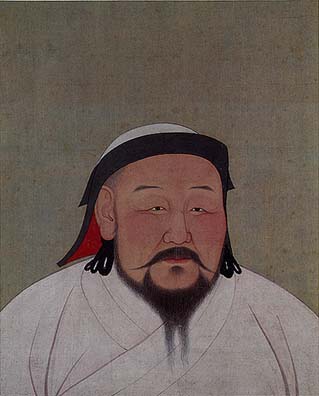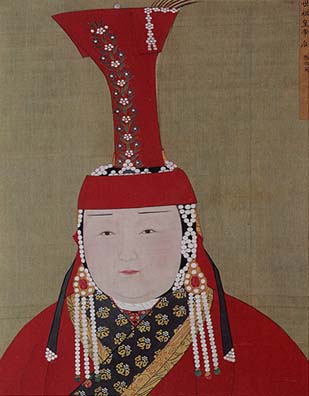 |
 |
|
Khubilai
Khan, first Yuan Emperor, |
Empress Chabi ( 察必皇后 ), Consort of Shizu |
|
by anonymous painter |
by anonymous painter |
Yuan Dynasty (1271 - 1368)
The
Southern Sung period, for all its cultural glories, is regarded by historians as
an age of weakness in the Chinese state, characterized by retrenchment in area
and influence, humiliating military impotence, and a mood of nostalgia bordering
on escapism. The conquest of China by the Mongols put China completely under
foreign rule for the first time. The
political policies of the Mongol rule did not have a widespread interruption to
the arts in China. Superficially, the Mongol ruling elite adopted Chinese
customs and habits. Painters liked to depict scenes of the ruling elite's life
of horse racing and hunting. Portrayals of horses had served for centuries as
pictorial metaphors for the character and special concerns of the Chinese
literati and scholar-officials and could carry a variety of auspicious wishes
and other messages.
 |
 |
|
Khubilai
Khan, first Yuan Emperor, |
Empress Chabi ( 察必皇后 ), Consort of Shizu |
|
by anonymous painter |
by anonymous painter |
Aristocratic mural painting and portraits of Genghis Khan & Kublai |
During
the Yuan Dynasty, painters turned more and more to express spirit and soul in
their art. Scholar artists became the leading figures in painting, and they
emphasized the expressive qualities inherent in brush and ink as a means of
portraying personality, thought, and emotion. Their painting was characterized
by simplicity, transcendence, and elegance.
Another
trait of Yuan literati landscapists is that they did not hide the process of
their painting, but rather allowed the traces of their brushes to be visible,
going considerably further in this direction than painters of the Sung Dynasty. For
instance, Huang Gong-Wang
painted
darker brushstrokes over lighter ones, and drier brushstrokes over
wetter ones, to create
richer textures and a stronger sense of tactile surface in his landscape
works.
|
|
|
|
Transition from Sung style painting to literati painting during Yuan Dynasty |
Dwelling in the Fuchun Mountains ( 富春山居圖 ) by Huang Gong-Wang |
|
Huang Gong-Wang ( 黃公望 ), 1269-1354 |
|
Huang Gong-Wang was the eldest and the most prominent of the four great landscapists of the Yuan Dynasty and he probably exercised more influence than any other painter on the development of the so-called "School of Chinese Literati Painting" during the Ming and Ching Dynasties. Huang decisively altered the course of landscape painting, creating models that would have a profound effect on landscapists of later centuries. He utilized modular construction in painting landscape masses with composites of dynamically interacting parts by infusing geometric or ovoid and arc objects repeatedly at some sacrifice of pictorial or descriptive values. His schematic and dynamic formalism had great influences on Ni Zan, Dong Chi-Tsun ( 董其昌 ), and the Four Wangs of the early Ching Dynasty. Generally speaking, the works of Huang Gong-Wang may be divided into two stylistic types. In one type of painting, he used light purple color, whereas the other type was executed in black ink only, the portrayal of the surfaces of rocks and trees being very much simpler in structure and technique than the first type. His famous essays "Secrets of Landscape Painting ( 寫山水訣 )" include theoretical pronouncements and techniques on brushstrokes, ink, colors, adding alum to silk and so on. Huang spent the remainder of his life in the Fuchun mountains near Hangzhou. In his famous Dwelling in the Fuchun Mountains, he utilized Zhao Meng-Fu's method of interweaving thick and dry brushstrokes to create visually tangible forms. He painted darker brushstrokes over lighter ones, and drier brushstrokes over wetter ones, to create richer textures and a stronger sense of tactile surface.
Huang Gong-Wang, Ni Zan, and Wang Meng
Dwelling in the Fuchun Mountains ( 富春山居圖 ) Flash version: http://www.npm.gov.tw/zh-tw/collection/selections_02.htm?docno=63&catno=15&pageno=3 This long handscroll by Huang Gong-Wang is among the most famous paintings in Chinese history. It is considered an epitome of literati landscape painting and has enormous influence on later ages. Depicted in this handscroll is an idealized panorama of the Fuchun mountains, west of Hangzhou, to which Huang returned in his later years. Beginning with a vast expanse of river scenery at the right, we move on to the mountains and hills, then back to areas of river and marsh that end with a conical peak. We finally come to the end of our wandering through the landscape as it ebbs out in the distant ink-wash hills over the water. The composition was first laid out in light ink and then finished with successive applications of darker and drier brushwork. Sometimes shapes were slightly altered, contours strengthened, and texture strokes or tree groups added here and there. Finally, brush dots were distributed across the work as abstracted accents. Buildings, tree limbs, and foliage are reduced to the simplest of forms as Nature has been translated into the artist's terms of brush and ink. According to his inscription, Huang wrote that he created the design in a single outburst of energy in one sitting. He worked on the painting on and off when the mood struck him from about 1347 to 1350. This representation of the Fuchun mountains was painted for a fellow Daoist named Master Wu-Yung and became Huang's greatest surviving masterpiece. Wu-Yung ( 無用 ), literally Worthless, was a facetiously self-deprecating sobriquet of the Daoist man. Worrying that someone else might get the painting, Wu-Yung urged Huang to inscribe in advance, in contrast to the convention that Chinese always inscribe on painting when or after it's finished.
Great Mountain of Fuchun ( 富春大嶺圖 )
Stone Cliff at the Pond of Heaven ( 天池石壁圖 )
Clearing After Sudden Snow ( 快雪時晴圖 )
Snow Scene of Nine Mountains ( 九峰雪霽圖 )
水閣清幽圖
|
|
Ni Zan ( 倪瓚 ) 1301 or 1306 -1374 |
|
Already by 1330s, series of floods, droughts, and consequent famine and peasant revolts brought this ideal existence to an end as the Yuan Dynasty began to unravel. For twenty years, beginning in 1351, Ni Zan wandered with his family through the southeast China, living in a houseboat or staying with friends and acquaintances, and often repaid their hospitality with his paintings. In his earlier paintings, he often painted widely separated riverbanks rendered in sketchy and ink monochrome brushwork and foreground trees silhouetted against the expanse of water. His sparse landscapes rarely represent people and defy many traditional concepts of Chinese painting. Many of his works hardly represent the natural settings they were intended to be depicted. Indeed, Ni Zan used his art as a medium of expression. In 1364, he said “I use bamboo painting to write (note) out the exhilaration in my breast, that is all. Why should I worry whether it shows likeness or not?” (note: Many Chinese brush painting masters often proclaim they are "writing objects" with brushes since most of the brush painting techniques were derived from the methodologies of Chinese calligraphy brushstrokes. Like all of the Four Masters of the Yuan painting, Ni Zan’s brush techniques originated from calligraphy.) Ni Zan landscapes truly bring out the great importance of brush work in Chinese landscape painting, especially that of the literati painting tradition. His minimalism turns every single brush stroke into an emotional statement that cannot be ignored. The almost compulsive repetition of themes throughout his career has never led his art to lose its originality and emotional vigor. Scholars read Ni Zan's paintings of simple, almost barren, and unpeopled landscapes as expressive of a longing for a simpler, cleaner, and peaceful world. Already shortly after Ni Zan's passing, the cultural levels of the families in Jiangnan, the southeast region of China, were evaluated according to whether or not they owned one of his works. Six Gentlemen ( 六君子圖 )
Rongxi Studio ( 容膝齋圖 )
Woods and Valleys of Mount Yu ( 虞山林壑圖 )
|
|
Chien Shuan ( 錢選 ) ca. 1235 - before 1307 (Pinyin: Qian Xuan) |
|
Returning after Resigning ( 歸去來辭圖 )
Squirrel on the Peach Stem ( 桃枝松鼠圖 )
Shu Miao Leaving the Calf ( 時苗留犢圖 )
Yang Guifei Mounting a Horse ( 楊貴妃上馬圖 )
Young Nobleman on Horseback
Eight Flowers ( 八花圖 )
|
|
Lee Kan ( 李衎 ) |
|
Bamboos & Rocks Bamboos
|